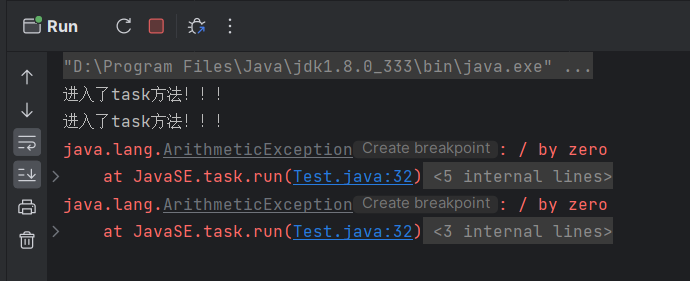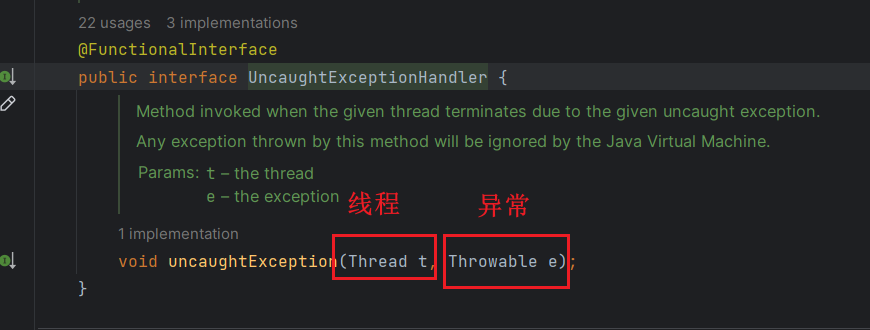【JUC进阶】如何优雅地处理线程池异常?
文章目录
- 1. 线程池异常的出现
- 2. 如何获取和处理异常
- 2.1 使用try-catch
- 2.2 使用Thread.setDefaultUncaughtExceptionHandler方法捕获异常
- 2.2.1 submit和execute源码分析
- 2.3 重写afterExecute进行异常处理
1. 线程池异常的出现
在开发中,我们经常使用线程池,会将不同的任务提交到线程池中,但是如果任务出现了异常,会发生什么呢?该怎么处理呢?怎么获取到异常信息来解决异常?
想要知道如何解决,就需要了解了解线程池提交任务的两个方法execute与submit
void execute(Runnable command);
Future submit(Runnable task);
由源码可见,两个任务最本质的区别就是execute无返回值,而submit由返回值。
接着用两个方法提交一个会抛出异常的任务看看发生什么?
public class Test {public static void main(String[] args) throws InterruptedException {//创建一个线程池ExecutorService executorService= Executors.newFixedThreadPool(1);//使用submit提交任务executorService.submit(new task());//使用execute提交任务executorService.execute(new task());}}
// 会抛出异常的任务
class task implements Runnable {@Overridepublic void run() {System.out.println("进入了task方法!!!");int i = 1 / 0;}
}

由输出结果可见
- 当线程池抛出异常后 submit无提示,其他线程继续执行
- 当线程池抛出异常后 execute抛出异常,其他线程继续执行新任务
当submit提交任务时,即使任务出现异常也不会打印异常信息,这是不友好的,这样开发者就不知道程序是否有异常。
其实,submit方法是将异常信息封装到其类型为Future的返回值中去了,想要获取异常信息,就必须使用get()方法
public static void main(String[] args) throws InterruptedException, ExecutionException {//创建一个线程池ExecutorService executorService= Executors.newFixedThreadPool(1);//使用submit提交任务Future submit = executorService.submit(new task());submit.get();//使用execute提交任务executorService.execute(new task());}

2. 如何获取和处理异常
2.1 使用try-catch
在任务中可能出现异常的地方使用try-catch捕获异常,然后抛出。
class task implements Runnable {@Overridepublic void run() {System.out.println("进入了task方法!!!");try {int i = 1 / 0;}catch (Exception e){e.printStackTrace();}}
}

2.2 使用Thread.setDefaultUncaughtExceptionHandler方法捕获异常
java.lang.Thread.setDefaultUncaughtExceptionHandler()方法设置处理程序时调用线程突然终止默认由于未捕获到异常,并没有其他的处理程序被定义为该线程。
public static void setDefaultUncaughtExceptionHandler(UncaughtExceptionHandler eh) {SecurityManager sm = System.getSecurityManager();if (sm != null) {sm.checkPermission(new RuntimePermission("setDefaultUncaughtExceptionHandler"));}defaultUncaughtExceptionHandler = eh;}
内部的uncaughtException是一个处理线程内发生的异常的方法,参数为线程对象t和异常对象e。

因此,可以自己实现一个线程工厂,为每一个线程创建的线程设置UncaughtExceptionHandler对象 里面实现异常的默认逻辑。
public class Test {public static void main(String[] args) throws InterruptedException, ExecutionException {//1.实现一个自己的线程池工厂ThreadFactory factory = (Runnable r) -> {//创建一个线程Thread t = new Thread(r);//给创建的线程设置UncaughtExceptionHandler对象 里面实现异常的默认逻辑t.setDefaultUncaughtExceptionHandler((Thread thread1, Throwable e) -> {//出现异常if (e != null){e.printStackTrace();}});return t;};//2.创建一个自己定义的线程池,使用自己定义的线程工厂ExecutorService executorService = new ThreadPoolExecutor(1,1,0,TimeUnit.MILLISECONDS,new LinkedBlockingQueue(10),factory);// submitFuture submit = executorService.submit(new task());submit.get();Thread.sleep(1000);System.out.println("==================为检验打印结果,1秒后执行execute方法");// executeexecutorService.execute(new task());}}

这里使用submit提交任务时,控制台打印的异常信息,其实是因为submit.get();,如果没有调用get方法,控制台只会打印一条异常信息,也就是execute出现异常时候而打印的异常信息。
那么,就说明了submit的返回值内部存有异常信息,那么为什么使用submit提交的任务出现异常的时候,没有打印异常信息呢?
其实是因为submit方法内部已经捕获了异常, 只是没有打印出来,也因为异常已经被捕获,因此jvm也就不会去调用Thread的UncaughtExceptionHandler去处理异常。
这需要结合submit和execute的源码分析
2.2.1 submit和execute源码分析
在submit源码中,可以看见,其实底层也是调用了execute方法,只是比execute封装多了一层RunnableFuture,而这个RunnableFuture就是submit的返回值。
public Future submit(Callable task) {if (task == null) throw new NullPointerException();RunnableFuture ftask = newTaskFor(task);execute(ftask);return ftask;
}
而在execute中,当任务数量少于核心线程数的时候,会调用addWorker(command, true)为每个任务创建一个Worker去处理这些线程
public void execute(Runnable command) {if (command == null)throw new NullPointerException();int c = ctl.get();if (workerCountOf(c) < corePoolSize) {//任务数量少于核心线程数量if (addWorker(command, true))return;c = ctl.get();}if (isRunning(c) && workQueue.offer(command)) {int recheck = ctl.get();if (! isRunning(recheck) && remove(command))reject(command);else if (workerCountOf(recheck) == 0)addWorker(null, false);}else if (!addWorker(command, false))reject(command);
}
这个Worker也是一个线程,执行任务时调用的就是Worker的run方法!run方法内部又调用了runworker方法!:
private boolean addWorker(Runnable firstTask, boolean core) {.............Worker w = null;try {w = new Worker(firstTask);final Thread t = w.thread;......
}public void run() {runWorker(this);
}
可见,当使用execute提交任务的时候,会被封装成了一个runable任务,然后进去 再被封装成一个Worker,最后在worker的run方法里面调用runWoker方法,runWoker方法里面执行任务任务。
在runWorker中,执行线程任务的是task.run();了
如果任务出现异常,用try-catch捕获异常往外面抛,我们在最外层使用try-catch捕获到了 runWoker方法中抛出的异常。因此我们在execute中看到了我们的任务的异常信息。
final void runWorker(Worker w) {Thread wt = Thread.currentThread();Runnable task = w.firstTask;w.firstTask = null;w.unlock(); // allow interruptsboolean completedAbruptly = true;try {//这里就是线程可以重用的原因,循环+条件判断,不断从队列中取任务 //还有一个问题就是非核心线程的超时删除是怎么解决的//主要就是getTask方法()见下文③while (task != null || (task = getTask()) != null) {w.lock();if ((runStateAtLeast(ctl.get(), STOP) ||(Thread.interrupted() &&runStateAtLeast(ctl.get(), STOP))) &&!wt.isInterrupted())wt.interrupt();try {beforeExecute(wt, task);Throwable thrown = null;try {//执行线程task.run();//异常处理} catch (RuntimeException x) {thrown = x; throw x;} catch (Error x) {thrown = x; throw x;} catch (Throwable x) {thrown = x; throw new Error(x);} finally {//execute的方式可以重写此方法处理异常afterExecute(task, thrown);}} finally {task = null;w.completedTasks++;w.unlock();}}//出现异常时completedAbruptly不会被修改为falsecompletedAbruptly = false;} finally {//如果如果completedAbruptly值为true,则出现异常,则添加新的Worker处理后边的线程processWorkerExit(w, completedAbruptly);}}
而submit方法t是将任务封装成了一个futureTask ,然后这个futureTask被封装worker成,在woker的run方法里面,最终调用的是futureTask的run方法,而在run方法里面,将异常吞掉了,并没有抛出异常,因此在worker的runWorker方法里面无法捕获到异常。
public void run() {if (state != NEW ||!UNSAFE.compareAndSwapObject(this, runnerOffset,null, Thread.currentThread()))return;try {Callable c = callable;if (c != null && state == NEW) {V result;boolean ran;try {result = c.call();ran = true;} catch (Throwable ex) {result = null;ran = false;//在此方法中设置了异常信息setException(ex);}if (ran)set(result);}//省略下文。。。。。。
在run方法中,如果出现了异常,不会将异常往外抛,则是将异常设置给outcome
protected void setException(Throwable t) {if (UNSAFE.compareAndSwapInt(this, stateOffset, NEW, COMPLETING)) {//将异常对象赋予outcome,记住这个outcome,outcome = t;UNSAFE.putOrderedInt(this, stateOffset, EXCEPTIONAL); // final statefinishCompletion();}
在submit方法返回值对象Future中,当调用Future.get()时, 会调用内部的report方法
public V get() throws InterruptedException, ExecutionException {int s = state;if (s <= COMPLETING)s = awaitDone(false, 0L);//注意这个方法return report(s);
}
在report中返回值实际上就是上面的outcome
private V report(int s) throws ExecutionException {//设置`outcome`Object x = outcome;if (s == NORMAL)//返回`outcome`return (V)x;if (s >= CANCELLED)throw new CancellationException();throw new ExecutionException((Throwable)x);
}
因此,在使用submit方法提交任务时候,任务对象Runable会被封装程Future类型。
future 里面的 run方法在处理异常时, try-catch了所有的异常,通过setException(ex);方法设置到了变量outcome里面, 可以通过future.get获取到outcome。
在submit里面,除了从返回结果里面取到异常之外, 没有其他方法。因此,在不需要返回结果的情况下,最好用execute ,这样就算没有写try-catch,疏漏了异常捕捉,也不至于丢掉异常信息。
2.3 重写afterExecute进行异常处理
在excute的方法里面,可以通过重写afterExecute进行异常处理,当然也适用于submit,但是因为submit的方式比较麻烦,submit的task.run里面把异常吞了,根本不会跑出来异常,因此也不会有异常进入到afterExecute里面。
在runWorker里面,调用task.run之后,会调用线程池的 afterExecute(task, thrown) 方法。
final void runWorker(Worker w) {
//当前线程Thread wt = Thread.currentThread();//我们的提交的任务Runnable task = w.firstTask;w.firstTask = null;w.unlock(); // allow interruptsboolean completedAbruptly = true;try {while (task != null || (task = getTask()) != null) {w.lock();if ((runStateAtLeast(ctl.get(), STOP) ||(Thread.interrupted() &&runStateAtLeast(ctl.get(), STOP))) &&!wt.isInterrupted())wt.interrupt();try {beforeExecute(wt, task);Throwable thrown = null;try {//直接就调用了task的run方法 task.run(); //如果是futuretask的run,里面是吞掉了异常,不会有异常抛出,// 因此Throwable thrown = null; 也不会进入到catch里面} catch (RuntimeException x) {thrown = x; throw x;} catch (Error x) {thrown = x; throw x;} catch (Throwable x) {thrown = x; throw new Error(x);} finally {//调用线程池的afterExecute方法 传入了task和异常afterExecute(task, thrown);}} finally {task = null;w.completedTasks++;w.unlock();}}completedAbruptly = false;} finally {processWorkerExit(w, completedAbruptly);}}
因此,我们在创建线程池的时候可以重写afterExecute方法
但是对于afterExecute处理submit提交的异常的时候,需要进行额外的处理,也就是判断Throwable是否是FutureTask
public class Test {public static void main(String[] args) throws InterruptedException, ExecutionException {//1.创建一个自己定义的线程池ExecutorService executorService = new ThreadPoolExecutor(2,3,0,TimeUnit.MILLISECONDS,new LinkedBlockingQueue(10)) {//重写afterExecute方法@Overrideprotected void afterExecute(Runnable r, Throwable t) {//这个是excute提交的时候if (t != null) {System.out.println("afterExecute里面获取到excute提交的异常信息,处理异常" + t.getMessage());}//如果r的实际类型是FutureTask 那么是submit提交的,所以可以在里面get到异常if (r instanceof FutureTask) {try {Future future = (Future) r;//get获取异常future.get();} catch (Exception e) {System.out.println("afterExecute里面获取到submit提交的异常信息,处理异常" + e);}}}};//当线程池抛出异常后 executeexecutorService.execute(new task3());//当线程池抛出异常后 submitexecutorService.submit(new task3());}
}class task3 implements Runnable {@Overridepublic void run() {System.out.println("进入了task方法!!!");int i = 1 / 0;}
}

参考:面试官:线程池中线程抛了异常,该如何处理?_Java精选的技术博客_51CTO博客
